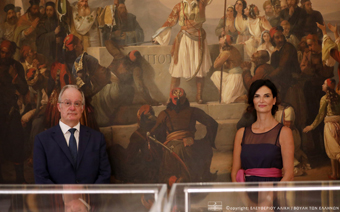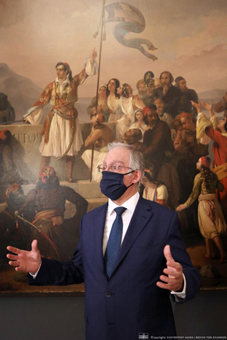Press Releases
Athens, 2 July 2021
Emblematic painting on theme of Greek Revolution at Hellenic Parliament on loan from Municipal Museum of Treviso

“Today the Hellenic Parliament welcomes in the Trophy room a trophy of liberty and art”. These were the words of the President of the Hellenic Parliament Constantine Tassoulas upon welcoming to the Hellenic Parliament the painting by Ludovico Lipparini “Lord Byron swears an oath at the grave of Markos Botsaris” on loan from the Municipal Museum of Treviso in Italy on the occasion of the 200 years since the Greek Revolution.
The presentation of the emblematic 1850 oil painting, which will be adorning the exhibition “Beholding Liberty! At the Hellenic Parliament, two centuries later”, took place today in the presence of the Ambassador of Italy in our country, Mrs. Patrizia Falcinelli.
The President of the Parliament, after expressing the gratitude of the Hellenic Parliament and the Greek people to the Ambassador of the friendly country of Italy and to the Museum of Treviso for loaning this magnificent painting, said the following:
“Today the Hellenic Parliament welcomes in the Trophy Room a trophy of liberty and art. A painting from the Museum of Treviso, a unique, one-of-a-kind, impactful painting, which represents the philhellenic gaze from Northern Italy and which at the same time expresses Italy’s desire for national unification.
In January 1824 Lord Byron arrives in Missolonghi and swears an oath on the grave of Markos Botsaris to liberate Greece. And we see in this painting the ensemble of figures that participated in the liberation of Greece. We see the military, ordinary citizens, the clergy who played such an important role both in the preservation of the national identity and the uprising for freedom. We see men, women, everyone, clearly gripped by emotion, repeating the same oath for the liberation of Greece. January 1824 is not an accidental period. The painting may be expressing the romantic dimension of Italian art, but the message if profoundly political. In January 1824 the Revolution is starting to wane due to civil strife. And Russia, at the same time, officially submitted the proposal to divide Greece into three principalities, similar to the Danubian ones, autonomous, paying tributes to the Sultan, not independent, and these principalities would be the principality of Western Greece including Epirus, Eastern Greece including Thessaly and the Peloponnese including Crete. The then Greek government, the Executive (“Ektelestiko”) as it was called, despaired. The plan, the dream, was independence, not autonomy, and they turned to the biggest European power of the time, England, to George Canning, then Foreign Minister of Great Britain and requested the protection of Great Britain.
Canning then responded to the government, and this was politically very significant as he acknowledged that there was a Greek government before the official proclamation of the Greek state, saying that he was willing to mediate with the High Porte in order to find a solution to the Greek issue.
At the same time Byron took an oath, i.e. at the time that Greece was slowly being recognised as a separate country, as a government, at war, philhellenism lifted us higher. Fortunately, we slowly escaped the civil passions. This lasted another five years and in the end we won our much coveted freedom.
The beauty, the emotion and the high aesthetics that this painting exudes move us profoundly today as well. Because it reminds us of one of the wonderful moments when Greece was inspired and provided inspiration. It inspired Lord Byron, it inspired Italy and it was inspired by the faith and trust that all these great philhellenes put in our country, as a country that inherited a deeply elevated culture. And vindication came a few years later”.
For her part, the Ambassador of Italy in our country, Mrs. Patrizia Falcinelli, expressed her joy at being in our country on the anniversary of the 200 years since the revolution “an event that represented a starting point and meeting point for all ideal impulses and interests associated with the new European sentiment”, as she said.
Referring to Italian philhellenism, Mrs.Falcinelli stressed that “many Italians, most of whom are today not acknowledged or have been forgotten, decided to come to Greece to make their contribution, even at the cost of their own lives. A sentiment that became a source of inspiration for many thinkers, philosophers, soldiers, poets and artists”. As she underlined, “one of them was the artist Ludovico Lipparinni, whose artworks – distinguished for their presence, stability and intensity towards the freedom of their characters – accompanied and described Greece’s independence”.
The Ambassador of Italy expressing the wish of her country to contribute to the celebrations of the anniversary of the Greek Revolution, announced the presentation of an original historiographic work on the participation of Italians in the Greek struggle for independence, a work that brings together a big group of distinguished historians, scholars and academics from Italy and Greece “as a tribute to Greece and to this culture that continues to honour the legacy of its glorious past”.
High resolution images
Back